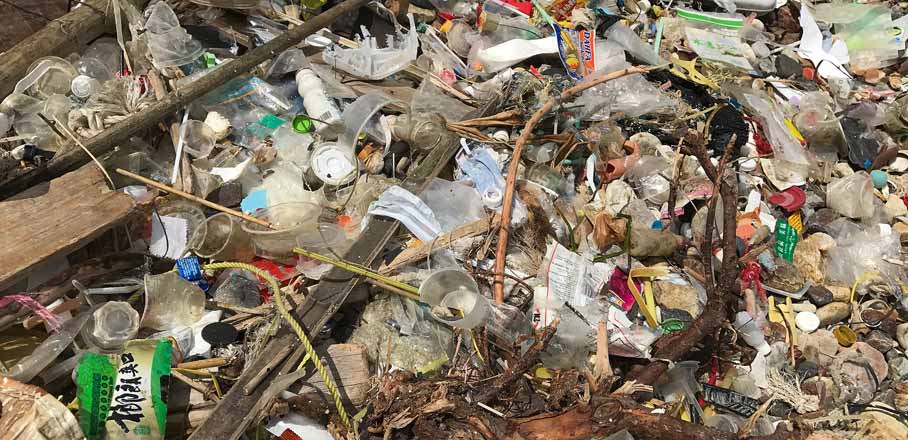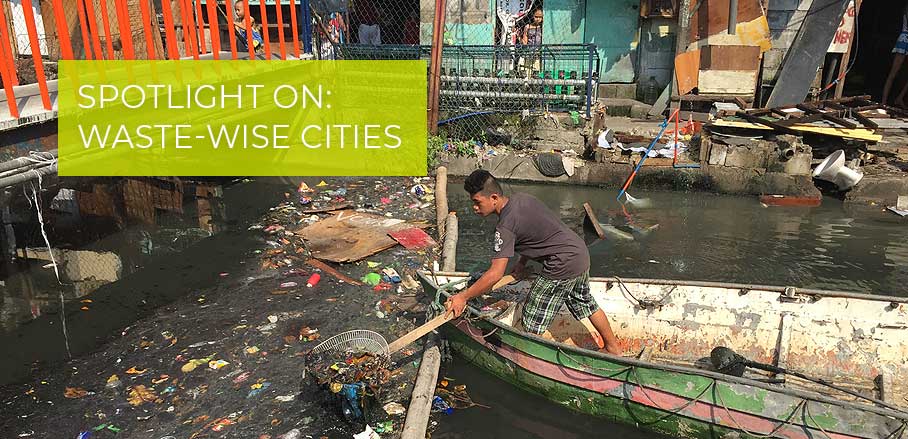From Plastic Waste Trade War to Circular Economy
Plastic pollution is an enormous environmental problem around the globe. It is only through the creation of functioning local and global circular economies that the problem can be solved. Doug Woodring, founder of Plasticity Forum and Trish Hyde, founder of The Plastics Circle, suggest a 5-point-plan to optimise plastic’s Second Life potential.
In a world reliant on global trade, plastic waste has become toxic. The heady mix of plastic waste, global damage, and national interest has sparked two sparring matches, and another is set to begin. What does it mean and what are the business take-outs?
How it All Started
Western countries have relied on trade under the guise of exporting recyclable resources, when in fact this process was “easy off-shoring” of domestic plastic waste liabilities. As much as 40 per cent of every bale shipped was not able to be recycled in the importing nation, therefore often entering the environment via dumping or toxic, open-flame burning.
Underlying the trade in plastic waste is the harsh reality that few countries participate in circular economics, and much of the world lacks the needed processes and infrastructure to create Second Life markets for their own local collection. Ironically, this includes two of the world’s wealthiest cities – Singapore and Hong Kong. While both have virtually 100 per cent collection coverage, limited local processing options means that half of the recyclables go to landfill or incineration, while export markets are sought for the rest, if they are collected, sorted, and recovered properly in the first place, which is not common.
Round Recap
In “Round 1” of the plastic pollution fight in early 2017, China announced its intention to cease accepting scrap plastic imports. Western industry insiders had been saying that this would never happen, which turned out to be a grave miscalculation. China successfully lodged the action with the World Trade Organisation citing human and environmental damage. In 2018, China ceased importing waste plastic, leaving plastic exporting nations with, what they declared a “plastic waste crisis”.

© Ocean Recovery Alliance/Plasticity
With China’s borders closed, “Round 2” saw Western countries turning quickly to new export markets – Malaysia, Thailand, Vietnam, and Indonesia. Like China, these countries felt, and feared, the harsh impacts of poor quality, contaminated imported plastics with nowhere to go except into the environment. In the end, they closed their doors too.
“Round 3” is on the way. Diplomats are considering a proposal to add mixed plastic waste to the Basel Convention list of materials requiring the recipient country’s informed acceptance. If successful, trading mixed plastic waste resources will change from being organised via business-led buying and selling, to one of government determination. Plastic waste exporting countries will need the informed consent from recipient countries (like Malaysia, Thailand, Indonesia, or China) in order for importation to be approved.
The Problem Grows
While waste plastic trading has existed under the banner of doing environmental good, its impacts on recipient nations has previously been swept under the carpet. Times have now changed, with the awareness of the health and environmental impacts of plastic pollution hitting a tipping point, supported by knowledge that plastic in the ocean is entering our food chain.

© Ocean Recovery Alliance/Plasticity
Global Calls for Local Action – From “Me” to “We”
In recent Plasticity Forums which always focus on business-led plastic circular economy solutions, there has been a consistent theme. One size does not fit all, and we need to move beyond theory into localised strategies.
Given that most companies or nations often cannot reuse all resources that are consumed, trade is essential. Trade, however, needs to be responsible, and the transfer of materials should only happen if they are needed for the creation of economies of scale from smaller markets to larger ones, while transferring only value instead of burden (waste).
The challenge we face is not whether plastic waste resources should be traded for valuable reuse, but instead, the challenge is shifting the discussion from “me” to “we,” and creating both local and global circular economies which can harness today’s waste streams.
Optimising Plastic’s Second Life Potential – The 5-Point-Plan
1. Complementary competitive advantage: There are many collaborators today who use their combined skills to create competitive advantage – from countries (regions like ASEAN), to country (financial capital), to industry (for example tourism). Consider the impact and results if a country like Singapore applied the same vigour it has used to becoming the region’s tech start-up hub and leveraging its capital markets, engineering and technical expertise to facilitate Asian collaboration in the new plastics circular economy.
The region has ample manufacturing capacities which could lead to innovations that open viable pathways for recovered plastic to compete with new materials. Which companies and countries will be the first to reap these rewards as they shun their outdated linear business models?
2. Not a recycling business: The collection of waste plastic, and its transformation into new goods for sale, should not be considered a “recycling business.” Instead, the use of recovered plastic should be considered a manufacturing operation, or an efficient use of materials by a brand. By focusing on fulfilling a customer need for a product and service, rather than simply trying to make a new “eco-product” that might not be needed, regular market forces come into play, functioning based on supply and demand.
The product is still the “hero” in the game in this case, while the material used for that product is “a support player,” but not deemed inferior because it is made of Second Life material (in fact, in some cases, it may now be appreciated as being a superior material due to its circular origin).
3. Policy: Governments and businesses wield much power through their procurement policies, and the adoption of policies which favour recovered content can easily be catalysts for change. Equally, waste management policies can favour high-quality, fit-for-purpose material that fits into Second Life markets, either at home or abroad.
Almost all materials can have a Second Life of some sort, if the capacities exist to pull them back into the market. This is where policy leadership is critical if innovation, job creation, and communal betterment is of interest to those in power.
4. Manage plastic to the hierarchy of value: Some plastics are highly valuable, and are likely to be recovered. Many others, due to low volume, weight or contamination, are perceived to be worthless. Creating value from so-called “tragic plastic” is a growing field of innovation that can be turned into a business, industry, and country-level competitive advantage.
Its “tragic” nature today is mainly due to outdated recovery systems or policies (both socially and technically), which are not tailored to complement the value that plastic waste can represent on any level of the value hierarchy. If materials are perceived to be “too hard to recover,” then they should be reduced from use in the market.
5. Apportion blame: Often we want a villain to blame. The sad truth is that we are ALL to blame, and we need to share the solution. Yes, governments can (and should) do more; but businesses play the biggest role, as they guide research and development, innovation, and consumer engagement. Communities can also make an impact, as they now have even more power to have their voices heard by governments, impact businesses via purchasing decisions, and encourage their communities to be showcases of global pride.
Above all else, new collaborations and shared responsibility can be created across business sectors and help to shift thought into action.
Douglas and Trish invite readers to join industry leaders and influencers at the next world-leading action-based plastic circular economy forum – Plasticity Amsterdam, June 19th, 2019.
- From Plastic Waste Trade War to Circular Economy - 9. April 2019
